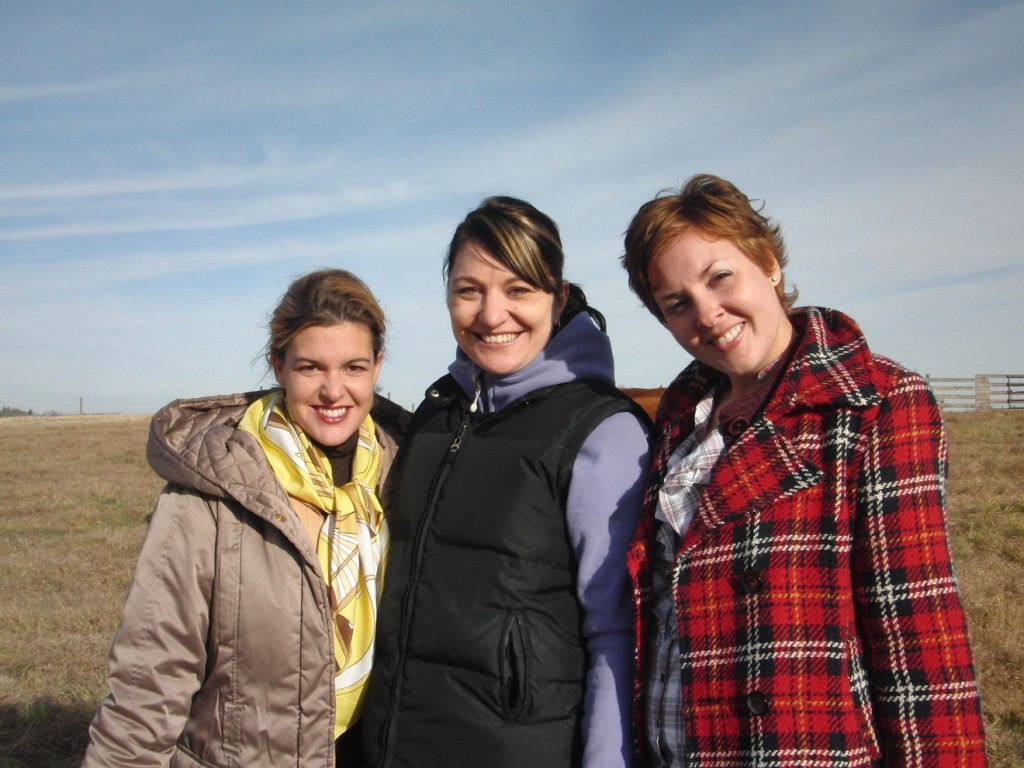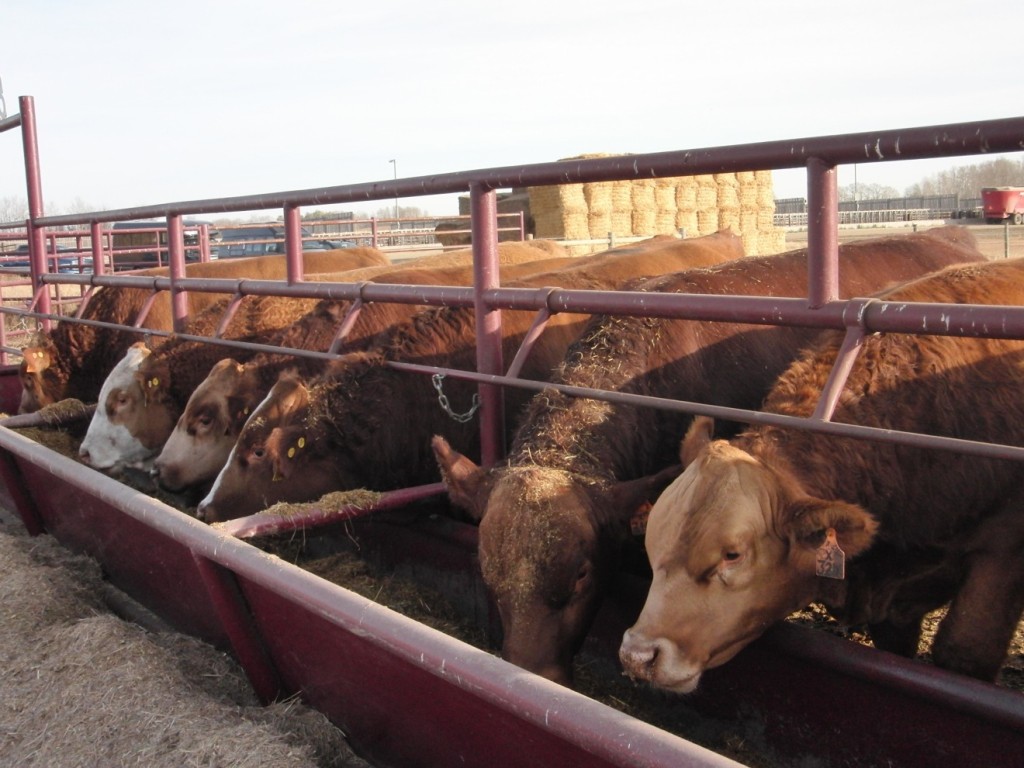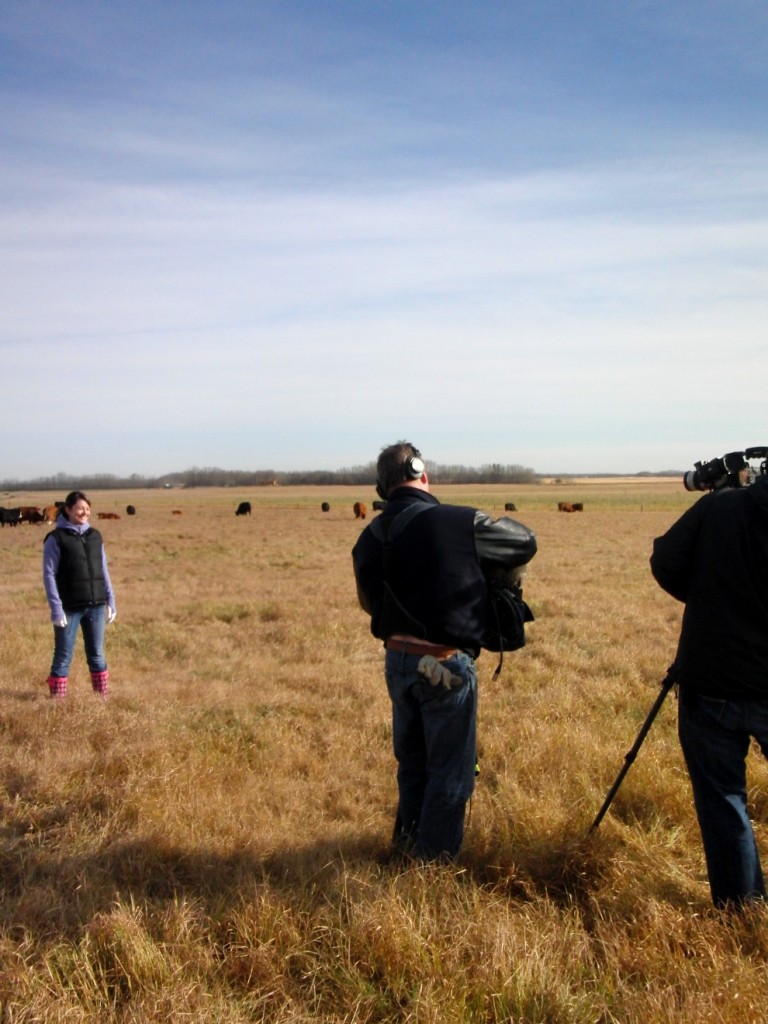
When I learned our third McDonald’s All-Access Moms trip would bring us to Cargill Meats in Alberta, where we would learn about how hamburgers are made, I wasn’t exactly looking forward to it. As I shared in my initial post announcing the trip, I was hesitant to go, because I was scared of what I might see. I returned from the trip and shared with my friends and family that I was really impressed with what I learned and thankfully, I can still eat Big Macs!
What goes into our beef is a concern, and this was mirrored by the comments and questions I received from readers to bring forward to the people who could answer them. Some common questions were, “What’s really in the beef?”, “Is 100% Beef a trademark name?”, and “What are the cattle fed and how are they treated?” I set out to find answers to these questions, and many more while in Alberta.
Our first day brought us to the Cargill Meats Beef Facility in Spruce Grove, Alberta. This single facility supplies hamburgers to all the McDonald’s restaurants across Canada and 3 million patties are processed daily! That’s a pretty mighty feat for a facility of its size. Stakeholders (the term Cargill uses for their employees, which I love) take huge pride in their work, knowing the reach their group has here in Canada. As a side note, this is something I’ve noted through all our trips – the pride in the people who supply the food to McDonald’s here in Canada is huge.
It’s difficult to explain everything we learned in one blog post, so I’m going to break it down by the questions brought forward by my friends, family, and readers and what I learned to bring back to them, in my own words. Hopefully this discussion will answer some questions you’ve had too.
So what’s in the ground beef that Cargill supplies to McDonald’s?
Hamburger meat is composed of the same cuts used in your grocery store roast and steak. Essentially it’s roast cuts and steak trimming.
Wait, where’s the other stuff I heard about on the web?
Probably in the same place other urban legends live. I saw the entire process from the beef being brought into the facility, cut up, in huge containers to it being ground up then pressed into a Quarter Pounder hamburger patty. Nothing was added to the meat in the process (no pink sludge, no ammonia, and other things that are reported online).
No ammonia? But I saw that on a documentary, who’s lying?
No one is lying. The documentary you saw was likely produced in the US and covers US food practices. The use of ammonia in beef is not approved in Canada.
The burgers taste different than the ones I make at home, they also look different. Why is that?
There are no seasonings added to the hamburger meat, but you likely do add seasonings at home. Also, when I make my burgers at home, they never look the same (truthfully sometimes they look like hamburger snowballs)! The hamburgers produced at Cargill are made by machine, so yes they will all look exactly the same, and likely not at all like your home-made burgers. Salt and pepper are added at the restaurant when grilling.
How do I know the meat coming out of the Cargill facility is safe, even if you say it doesn’t have anything added?
Cargill performs more than 2,400 recorded quality and food safety checks every day. The production line has two metal detectors to find any trace of foreign materials. Cooked patties from the production line are evaluated for their consistency related to appearance, texture, and flavour and these tests are performed every 30 minutes, which means 40 times daily.
On the second day, we visited a farm that supplies beef to Cargill. This, of course, is the first step in the beef production process. I had never been to a large scale feed lot but again, read about some of them on the internet and wasn’t sure what to expect. Here’s what I learned about the beef production process as it begins “down on the farm”.
Cows calve in the winter months indoors. Calves stay with their mother for about 8-9months (this is when they are weaned too) until they enter the second step in the process at about 10-12 months. During their first nine months of life, the calves graze on pastures and grasslands.
Once they enter the feed lots, they stay for a total of 90-200 days and gain about 3-3.5 pounds per day. The cows eat a combination of grasses and barley in the feed lot.
 I thought a feed lot would look more like a production-line place, where cows were there only to eat and not move about much at all. Me being, well…me…didn’t even realize we were IN the feed lot until we were leaving. I thought we were near the pastures because my perception of a feed lot was nothing like what I saw. The cows had tons of room to roam around, graze and run. Feed lots here in Canada range in size, holding anywhere from a few hundred head to over 40,000.
I thought a feed lot would look more like a production-line place, where cows were there only to eat and not move about much at all. Me being, well…me…didn’t even realize we were IN the feed lot until we were leaving. I thought we were near the pastures because my perception of a feed lot was nothing like what I saw. The cows had tons of room to roam around, graze and run. Feed lots here in Canada range in size, holding anywhere from a few hundred head to over 40,000.
People have concerns about animal welfare and animal treatment which is understandable. Living in Saskatchewan my entire life, it always makes me shake my head when people question a farmer’s integrity when raising cattle or other animals for slaughter. What I have always known, and more people need to understand, is that a farmer’s livelihood is in his livestock. It is, quite literally, what puts food on his table for his family and a roof over their heads. To mistreat the very product that ensures his livihood makes no sense. A farmer takes pride in his livestock and his land – this I know after 34 years on the prairies.
Still, it’s important to have procedures and policies in place to make sure our animals are treated ethically and humanely, and all beef cattle that are supplied to Cargill are treated in compliance AMI’s guidelines for humane treatment of animals.
In fact, world renowned expert in animal welfare, Temple Grandin, was quoted as saying, “McDonald’s should be given credit for bringing about improvements in animal welfare in the entire beef industry…I have been in business for more than 25 years and have never seen such a transformation.” You see, the policies McDonald’s brought in have shaped policies for the entire industry as well.
Next, we looked at answering questions many moms have about hormones and antibiotics in our food.
Are hormones used in the beef that Cargill uses to make McDonald’s hamburgers?
Yes. Hormonal growth promoters are given to increase lean tissue growth which results in a healthier product (less fatty) which is produced at a lower cost to the consumer. Basically, the cow grows faster spending less time in the feed lot, consuming less food as a result, and keeping the production moving along, so to speak. It is not just McDonald’s that uses hormonal growth promoters, this is a practice of the Canadian Beef industry and the use is regularly monitored by the CFIA.
Some people think that our cattle should be raised without hormones being used (that is, additional hormones as of course, all meat would have naturally occurring hormones in it) and this is possible to do, though the cost to the consumer would increase as a result. The Health Canada website (www.hc-sc.gc.ca) has more information about hormonal growth promoters.
So ammonia isn’t used but you can’t tell me antibiotics and vaccines are not used in beef production. Antibiotics are bad, right?
No, unhealthy, sick, cattle would be very bad! Vaccines are given at birth and then again 3-6 months. Antibiotics are given when a cow is showing signs of sickness. A cow that has had antibiotics must go through a withdrawal period before it could be sent to slaughter, to ensure that there’s no residual left in the meat. CFIA (Canada Food Inspection Agency) does random checks to ensure that these rules are being followed.
 When the McDonald’s All Access Moms had completed our trip, we then had our usual Q&A with the producer and film crew that are capturing our tours to air in segments on CityLine, through national commercials, and on the McDonald’s All Access Moms site. When asked what surprised me most on this tour, my reply was that I was surprised by how simple the entire process is.
When the McDonald’s All Access Moms had completed our trip, we then had our usual Q&A with the producer and film crew that are capturing our tours to air in segments on CityLine, through national commercials, and on the McDonald’s All Access Moms site. When asked what surprised me most on this tour, my reply was that I was surprised by how simple the entire process is.
No mystery meat or parts used to make McDonald’s hamburgers. No documentary-worthy ingredients added to the meat to wash it, and a clear explanation about the role of hormones, vaccines and antibiotics in the beef production process that make sense to me, with references readily given to government standards and protocol for further reading.
I worried that I would not be able to eat hamburgers after this trip, but quite honestly, I feel better about eating ground beef and McDonald’s hamburgers after going on this trip and learning about ground beef production.
Hopefully, I helped answer some nagging questions fellow moms have about McDonald’s hamburgers. Now you can dispel the myth out there about the “100% Pure Beef” being a trademark name and ask your friends if they know that McDonald’s hamburger meat is made from the same cuts of beef as Sunday’s roast beef dinner.
I know that these answers won’t please everyone. There are groups that are anti-McDonald’s and that’s fine. The purpose of this program, and my enthusiastic role as part of it, has nothing to do with trying to convince people who hate a company to go eat a French fry.
This program is not for them.
This program is for moms just like me who eat at McDonald’s with their children and want to know more about the food we’re eating. It’s about education and using that information to make the decision you see fit for your family.







well written=)
I am still a little skeptical about and not too fond of McDonalds… but this has definitely helped me not feel so bad about my once or twice-a-year cheeseburgers 🙂
You’ve been very honest with this whole process, and I appreciate, from a Mom who also takes her kids to McDs, knowing more about what is going on. My biggest problem with McDs is that it just isn’t that good for me 🙂 But it is still tasty!!
Thanks! It certainly helps me to feel better about my rare burger at McD. Though, still, for as long as I can, I’d prefer to keep my kids far away from them altogether.
Do they have a ‘Moms’ program in the US? If anyone knows…..I would like to find this same type of info on US McDonalds beef. Great post.
I’m glad you did this, I am not ashamed to say I grab McDonalds for me and my kids every now and again, perhaps I would be if it wasn’t on this post :p McDonalds is definitely offering healthier choices- apple slices in a happy meal and milk- it’s not so bad 🙂
I don’t eat beef {cause look how cute those little cows are!} but I like knowing this stuff since my fiancee DOES eat beef. Although I kind of wish I lived in Canada since it’s implied that ammonia may be in the US beef! Eek! Otherwise, I’m impressed.
High !
It’s great you included the hormones, but what you didn’t include was the slaughter house practices.
What they don’t want you to know is that the Cows are slaughtered to religious laws, particularly Kosher and Halal
In both cases, the animals are slaughter by slicing the throat, and letting the animal bleed out while conscious, and the CFIA allows this. With the Kosher method, all the prime cuts are sold, and the meat from the hind quarters of the animals are then ground up as hamburger because Jewish laws don’t allow meat from around an animals anus to be consumed.
I strongly suggest you view these Youtube videos documenting the slaughter of cows for these archaic religious philosophies.
Koshier slaughter house in USA – http://www.youtube.com/watch?v=ARsWQAb0QyY
Halal slaughter – http://www.youtube.com/watch?v=h_bZzxep87c
I’m not some animal activist or anything, In fact I grow my own meat, and kill my animals as quick and painlessly as possible. What they have going on here in Canada and abroad is an offense, and you need to bring light to that part of the process.
Yes. I would love to know about US!
I have to say, the feedlot you visited is vastly different than feedlots here in America (that I’ve seen). And I would never eat at McDonald’s here in the US due to the practices used in ‘washing’ the meat (with ammonia)….however, I might eat at a Canadian McDonalds. It’s funny how when a country refuses to allow a certain practice, the company complies. The US could learn a few things from Canada. Thanks for a great write up and your honesty.
Susie homemaker / Jenny – for info on how hamburger meat is processed in the US, you can watch Food Inc. The long and short of it is the meat is washed with ammonia to prevent ecoli bacteria.
I don’t like the taste of any hamburgers from fast food joints, but I do looooove McDonald’s french fries!
From your disclosure:
“This blog accepts forms of cash advertising, sponsorship, paid insertions or other forms of compensation.
The compensation received will never influence the content, topics or posts made in this blog.”
Really?
I’m not saying McD’s is totally evil, but we all know which side of the food pyramid of health choices they sit. How much were you paid for these posts, and how much has your editorial angle been swayed by your desire to keep a paying client happy?
Is there separation of church and state with your blog or are you so pr friendly the voice has been lost?
Yes, really. “DadCAMP”, I’ve been a “mom blogger” for 3 years now and have gained a tremendous audience in that time. My readers know that my opinions are honest, candid, and if I’m not happy about something, I’ll share that too.
Yes I was paid for the All Access Moms Program, that’s never been disputed. As for the amount, frankly it’s none of your business. If you ask me how much I weigh, I’m not sharing that with you either.
I read the article you sent me (and the other moms, one after the other) on Twitter and it’s obvious you have some concerns about bloggers “selling-out”, and that’s what has prompted your interest in this program and the moms involved.
I get that.
I do think, however, that you’re not giving my 1000’s of mom readers much credit. These women are intelligent, inquisitive and objective mothers looking for answers. They can see through BS and if they don’t like my writing or any other blogger’s…they leave and will read someone else.
The fact that my readers stick around tells me they value and trust what I have to say. If you took any amount of time to get to know me or the other bloggers in this campaign, it may help. Then again, you probably have no interest in that, it’s easier to assume and shake your fist at the almighty corporate meanies instead.
Amen to that.
Baahaaahahahahaaaaa. I love you Tenille. So well spoken, even to people that seem to hate what they simple can’t understand! Bravo
Tee hee…someone missed the “Feisty” part of your blog name! 😉
I have never known feisty frugal and fabulous to be anything but candid. I have been suprised at how candid Tenille has been in her blog, and I personally appreciate it. Just as she mentioned in the one blog about a white curtain they could not go behind on a McDonalds tour. She is honest and upfront. It is not about money it is about speaking the truth. If she found something questionable it would be stated here… GO FRY a hamburger with no salt or pepper… Guess what it tastes just like McDonalds… Where the fat or unhealthy portions comes in, is in their sauces that are used. Those are prepackaged items… Bottom line is her voice has NOT been lost… but I personally will not frequent your blog Dadcamp because I see you just wish to sling accusations. Get to know someone or something before you sling accusations about them or their job.
I want to thank you for taking the time to go look at and observe the process of supplying Beef to McDonalds. As a former employee from the 80’s, I’ve constantly defended the ingredients of the food that McDonald’s and for that matter many other quick food companies use. Nothing was more aggravating than trying to convince people there was no Kangaroo in their Big Mac or that the eggs were not all powder.. I even have issue with the movie “Supersize Me” admittedly, I have not seen it, however I ate at McDonald’s 3 times a day, 6 days a week for almost the entire 9 years I worked there (as a manager, i was allowed my meals for free) and I kept the same wimpy 120 lb frame for the entire time I worked there. I am at my heaviest now as I try to keep myself fit, exercising albeit sporadically and eating clean. I don’t eat the food at Mcdonald’s or any other quick food company very much anymore but I would NEVER hesitate to if I needed a quick, tasty fix. And the Big Mac is still my favourite…
You’re welcome Michael! That was the whole point – share the story, not try and convince anyone why they *should* eat McD’s, the choice is yours in the end. The next time you hear some weird story or comment, share this link! Happy new year.
GREAT story, I’ve heard so many claims, the craziest that the meat was actually seaweed?! Ridonkulous!
curious if you were in the slaughter house as well. Having worked at one (Mitchell’s in Saskatoon, which was bought by Schneiders and then bought by Maple Leaf) They did pigs in Mitchell’s but it took me a very long time before I could actually eat pork.
No slaughter house on the beef tour but we did visit the Cargill Chicken Facility in November for the chicken tour and saw the chicken slaughter. Much less traumatic than the beef I’m sure, and I’m ok with eating chicken still if I can stop the visuals from that day, lol!
Thanks for sharing the info on how they get the flavor, that’s always interested me (Because I love me some McD’s burgers hee hee). I wonder if they prepare the burgers the same way in the US? (Never had McDonald’s in Canada, although I did eat a burger on the Champs-Élysées…LOL!!)
I found this a little late, you might say, but I want to thank you for the information. Sensationalism drives so much of our information and it’s refreshing to see these types of reports. My grandmother taught be about balance, so a Big Mac a day is not in order but we don’t have to light our torches and occupy McD headquarters either. Well done.